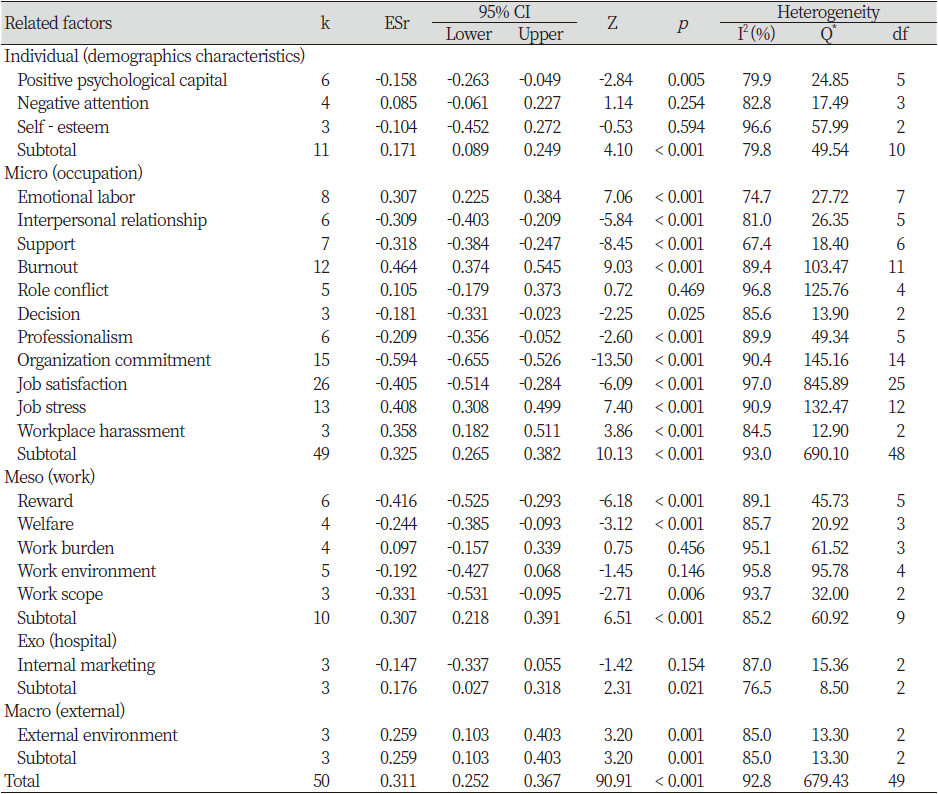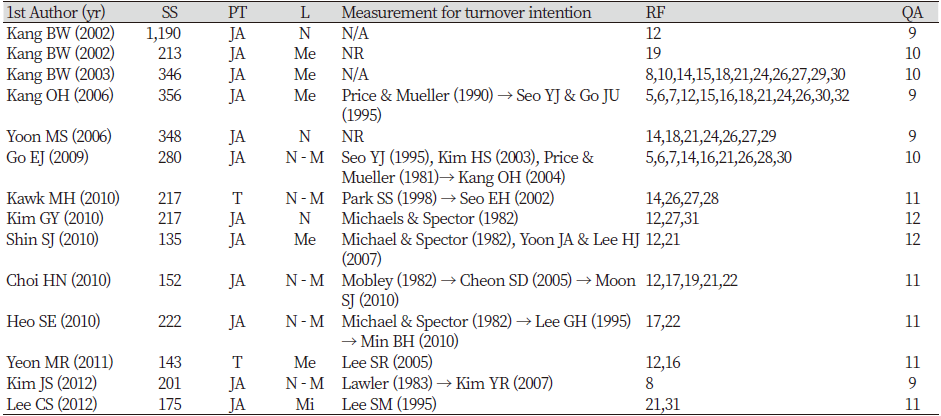서론
치과의료서비스에 대한 국민적 요구도가 높아진 상황에서 치과위생사의 수급 문제와 이직의 본질적 문제 해결에 대한 의견이 팽배한 실정이다. 최근 치과위생사는 매년 4천2백여 명이 배출되고[1] 있으며 면허 등록자 수는 8만3천8백 명에 달한다[2]. 하지만 실제 치과의료기관에 종사하는 치과위생사는 3만 5천명으로[2] 면허등록자의 절반에 미치지 못하고 있다. 치과위생사 이직률은 75.6%로 평균 2.5회의 이직횟수를 나타내고 있기 때문이다[3].
이직의 긍정적 평가로 조직적 측면에서는 유능한 인력으로 대체가 가능하며 새로운 변화를 촉진할 수 있고[4], 개인적 측면으로는 역량 강화를 할 수 있는 새로운 기회를 얻을 수 있다는 점에서 발전적으로 볼 수 있다[5]. 하지만 조직 구성원이 바뀌면서 숙련되지 않은 인력으로 인한 의료서비스의 질적 저하가 야기되고[6], 조직의 경영성과에 손실을 가져오며[7], 동료에게 불편감을 초래하는 문제점이 유발될 수 있다[8]. 또한 구성원들의 이직률이 높다는 것은 해당 조직에 불만족인 구성원들이 많다는 의미를 내포하고 있기 때문에 조직 이미지에도 손상을 줄 수 있다[9]. 따라서 치과위생사 이직의 본질적 요인을 파악하고 이직률을 낮출 수 있는 방안을 찾을 필요가 있다.
이직에 관한 선행연구 대다수는 이직이나 이직률을 종속변수로 설정하지 않고 이직의도를 이용하고 있다. 이직 자체의 행위변인을 추적 조사하는 과정상의 난제도 있으나, 이직의도는 이직을 유발하는 직접적인 원인이며[10,11], 이직을 예측하는 실용적인 자료로[12] 실증분석 사례에서도 의미가 수차례 검증되었기 때문이다[13]. 따라서 치과위생사의 경우도 다양한 이직의도 관련 연구들을 통해 이직 원인을 파악하고 있었다. 그러나 각 연구들은 특정 대상과 변수만을 이용하여 독립적인 결과물들을 제시하고 있다. 그러므로 개별연구들로부터 종합적인 결과를 도출하는 체계적인 분석방법을 통해 중점적으로 다루어야 할 요인을 총체적으로 파악할 필요가 있다.
이에 본 연구에서는 다양한 학문에서 유용성을 확인받은 생태체계모델을 이용하여 치과위생사의 이직의도 관련요인들을 분류하고 영향력을 검토하고자 하였다. 생태체계모델은 개인을 다각적 차원에서 이해하며 접근할 필요성이 있음을 5개의 분류 체계를 근거로 설명하고 있다[14]. 그러므로 치과위생사 이직의도 관련요인을 생태체계별로 유목화하여 효과크기를 검증하고 중점적으로 다뤄져야 할 체계와 관련요인들의 통합적인 결론을 제시할 수 있을 것으로 기대된다. 이를 통해 추후 치과위생사의 고용 안정과 발전을 위한 정책 개발의 방향성과 중재 전략의 방향성을 제시하는 기반을 제공하고자 한다.
연구방법
1. 연구설계
본 연구는 한국 치과위생사의 이직의도 관련요인에 대해 양적 연구한 개별 연구를 체계적으로 고찰하였고, 생태체계이론[14]을 적용하여 관련요인을 유목화한 연구모형을 설계하였다<Fig. 1>. 생태체계의 중앙에 위치한 개인은 성격과 기질을 포함한다. 미시체계(microsystem)는 근무환경 속에서 개인이 직접 상호작용을 하는 직장 동료 및 환자와의 다양한 감정과 경험 등의 요인을 포함한다. 중간체계(mesosystem)는 근무행태와 만족에 영향을 주는 보상, 복지, 업무 부담과 업무 환경 등의 요인을 의미하며, 외체계(exosystem)는 소속되어 있으나 능동적으로 관여하지는 않는 병원의 행정과 경영에 관한 운영적 특성을 의미한다. 거시체계(macrosysmet)는 정치, 경제, 문화, 사회적 규범 등의 광범위한 사회환경 특성을 의미한다.
2. 문헌선정기준 및 배제기준
문헌 선정을 위해 ‘한국 임상치과위생사의 이직의도 관련요인은 무엇인가?’를 이직의도 관련요인 핵심질문(Participants, Intervention, Comparisons, Outcome, Study design, PICOS)으로 설정하였다. 국내외 전자 데이터베이스 검색을 위한 선정기준은 1) 2000년 이후 출판, 2) 한국 임상치과위생사(participants), 3) 이직의도 관련요인(intervention), 4) 이직의도 제시(outcome), 5) 양적연구(study design), 6) 상관계수 값이 제시된 문헌이었다. 배제기준은 1) 전문을 구할 수 없는 문헌, 2) 결과변수에 이직의도를 포함하지 않은 문헌, 3) 통계치를 제시하지 않은 문헌, 4) 특정 하위요인만 상관계수가 제시된 문헌, 5) 효과크기를 구할 수 없는 질적 연구나 문헌, 6) 한국어 또는 영어가 아닌 언어로 된 문헌이었다.
3. 문헌검색 및 선정
본 연구는 Cochran collaboration의 체계적 문헌고찰 핸드북인 PRISMA(Preferred Reporting Items for Systematic Reviews and Meta-analysis) 지침에 의거하여 수행하였다<Fig. 2>.
2020년 9월부터 2021년 1월까지 문헌검색을 하였다. 국내 문헌은 한국학술정보(Korean Studies Information Service System, KISS), 대한의학학술지편집인협의회(KoreaMed), 한국교육학술정보원(Research Information Sharing Service, RISS), 누리미디어(DBpia), 한국과학기술정보센터(NDSL), 국회도서관(Nanet), 국립중앙도서관(NLK) 한국의학데이터베이스(Korean Medical Database, KMbase)에서 검색하였다. 국외 문헌은 의학분야 전자데이터베이스(OVID Medline & Pubmed), 유럽의학분야전자데이터베이스(Excerpta Medica dataBASE, EMBASE)를 이용하였다. 검색식은 선행연구를 참고하여 MeSH 용어, 제목과 초록의 text word를 AND/OR 및 절단 검색을 적절히 적용하였다. 한국어 검색어는 ‘치과위생사’ AND (‘이직의도’ OR ‘이직’)이었고, 영어 검색어는 (‘dental hygienists’ [MeSH] AND ‘Korea’ [MeSH]) AND (‘turnover’ OR ‘intention’ [MeSH] OR ‘employment’ [MeSH] OR ‘quitting’ OR ‘occupation’ [MeSH])이었다.
이후 서지반출 프로그램 엔드노트(EndNote X9)를 이용하여 771편의 문헌이 중복되었음을 확인하여 총 269편을 선정하였다. 본문을 확인하여 기준에 부합하지 않는 49편과 결과변수로 이직의도를 보고하지 않은 108편, 상관계수가 없는 28편, 질적 연구 등 효과크기를 구할 수 없는 11편, 타 직종이 포함된 10편, 남자 치과위생사만으로 한정한 1편, 통계치 오류로 값을 신뢰할 수 없는 4편, 동일한 주제에 대하여 공통의 데이터를 이용한 3편, 하위요인만을 제시한 4편, 2000년 이전 연구 1편을 제외하였다. 선별된 문헌을 최종 검토하여 총 50편을 선정하였으며 체계적 문헌고찰을 시행한 결과 32개 요인으로 유목화하였다. 메타분석을 위한 문헌선정 기준은 요인별 2편의 연구물이 있을 때 가능하지만, 본 연구에서는 정밀도를 높이기 위하여 3편 이상일 경우로 한정하였다.
4. 문헌의 질 평가
문헌의 질은 Law 등[15]의 Critical review form에서 제시한 연구목적과 문헌고찰, 설계, 표본(자세한 기술, 표본크기 정당화), 측정변수(신뢰도, 타당도), 중재방법(중재 설명 여부, 중재 오염, 중복 중재 여부), 결과(통계적 유의성, 분석방법, 임상적 의의, 대상자 탈락 기록), 결론과 함축으로 15항목이었다. 두 명의 연구자가 독립적으로 평가하였고, 일치하지 않는 경우는 함께 재검토하여 논의하며 조율하였다. 이후 선정문헌 모두 평가기준을 충족하여 50편을 분석에 이용하였다.
5. 자료 분석
자료 분석은 R 4.0.5 프로그램의 ‘meta’와 ‘metafor’ 패키지를 이용하였다. 효과크기 산출은 임상치과위생사의 이직의도 관련요인에 대한 상관계수(r) 효과크기를 사용하였고, 메타분석에서 개별 r값을 표준화한 Fisher’s Z로 변환하였다[16]. 체계 별 총 효과크기 산출에서 역방향을 가진 요인들을 병합할 경우 상쇄효과로 효과크기가 작아지지 않도록 연구자가 효과의 방향을 설정하였다[16]. 선정한 문헌은 무선효과모형(random effects model)을 적용하여 Cochrane의 Q통계량, Higgins의 I2통계량으로 통계적 이질성을 평가하였다. 전체 분산 값으로 실제 분산과 표집오차를 더한 Q통계량 값을 근거로 동질성 검사를 시행하여 p값이 0.1보다 작은 경우 문헌들 간 이질성이 있다고 판단했다. 총 분산에 대한 실제 연구간 분산의 비율인 I2통계량이 25% 미만이면 이질성이 작고, 25-75%이면 중간, 75% 이상이면 이질성이 크다고 해석하였다[17]. 출판편의 경향성은 시각적으로 평가할 수 있는 Funnel plot[18]을 이용하였고, 이를 보정하기 위해 Trim-and-Fill 방법[19]으로 대칭화하였다. 선정문헌의 효과크기는 작은 효과크기(r=0.10), 중간 효과크기(r=0.30), 큰 효과크기(r=0.50)로 해석하였으며, 95% 신뢰구간에 ‘0’이 포함되었는지를 통해 유의성을 판단하였다[20].
연구결과
1. 분석대상 문헌의 특성
최종 선정한 50편의 문헌은 2000년부터 10년까지 12편(24%), 11년부터 15년까지 21편(42%), 16년부터 21년 1월까지 17편(34%)이었다. 연구지역은 비수도권이 20편(40%), 수도권과 비수도권 혼재가 12편(24%), 수도권이 12편(24%), 전국단위가 4편(8%)이었다. 출판유형은 학술지 논문이 37편(74%), 학위논문은 13편(26%)이었다. 이직의도 측정도구는 제시하지 않은 6편을 제외하면 Lawler 도구를 가장 많이 이용하고 있었다<Table 1>.
2. 생태체계 별 이직의도 관련요인 효과크기
이직의도 관련요인의 전체 효과크기는 0.311로 중간크기였고, 직무만족과 조직몰입, 직무스트레스, 소진 요인이 10편 이상의 문헌에서 보고되고 있었다. 생태체계별 효과크기는 미시체계(0.325), 중간체계(0.307), 거시체계(0.259), 외체계(0.176), 개인(0.171) 순이었고, 모두 중간 효과크기를 나타냈다. 관련요인 수는 미시체계가 11개로 가장 많았고, 중간체계(5개), 개인(3개), 외체계와 거시체계(1개) 순이었으며, 미시체계 중 조직몰입의 효과크기 값이 가장 높은 –0.594였으며, 통계적으로 유의하였다. 중간 값을 나타낸 19개 요인 중 15개 요인이 유의하였으며, 상위 5개의 요인은 미시체계의 소진(0.464), 중간체계의 보상(-0.416), 미시체계의 직무스트레스(0.408)와 직무만족(-0.405), 직장 내 괴롭힘(0.358)이었다. 작은 효과크기에서는 유의한 요인이 나타나지 않았다. 32개의 관련요인 중 3편 이상의 문헌에서 다루고 있는 요인이 21개 요인이었고, I2값은 92.8%로 이질적인 분포를 보였다<Table 2>.
|
Table 1. To be continued 
|
|
k: Number of studies, ESr: Effect size, CI: Confidence interval *Cochrane’s Q statistics, p<0.1 |
3. 출판유형에 따른 효과크기
연구물의 출판유형에 따른 효과크기는 학위논문이 0.359로 학술지 논문(0.294) 보다 높았으나 출판유형 간 통계적인 차이가 없었다(Q=0.95, p=0.332).
4. 출판편의
개별 효과크기들의 전체적인 분포는 좌측으로 편향된 비대칭으로 출판편의가 확인되었다. 이를 보정하기 위해 trim-and-fill 방법으로 8편의 문헌을 추가하였다. 효과크기는 보정 전 0.311(95% CI: 0.252~0.367)에서 보정 후 0.361(95% CI: 0.303~0.415)로 15% 증가하는 경향을 나타냈다<Fig. 3>.
총괄 및 고안
본 연구는 생태체계모델을 적용하여 임상치과위생사의 이직 의도에 관한 문헌을 체계적으로 고찰하고 메타분석을 시행하여 관련요인의 영향력과 효과크기를 분석하였다. 문헌의 출판시기별 양을 분석한 결과 2010년까지 24%에서 2011년 이후 76%로 급속히 증가하고 있었다. 치과위생사 이직률이 2020년 기준 70% 이상을 상회하고 있으므로[21] 사회적 문제로 인식하고 원인을 찾아 해결하고자 하는 노력이 반영되고 있음을 알 수 있다. 연구대상 지역은 수도권역에 비해 비수도권역이 많았다. 복지조건이 보다 나은 수도권으로 치과위생사가 집중되는 경향이 많으므로[22] 비수도권에서의 치과위생사 이직 문제가 상대적으로 더 심각하기 때문인 것으로 사료된다. 따라서 치과위생사 이직의 근본적인 문제 해결은 물론 지역 간 불균형 현상도 해결해야 할 과제로 생각되었다. 이직의도를 정확하게 파악하기 위해서는 측정도구가 중요한데, Lawler[24] 도구를 가장 많이 이용한 것으로 분석한 본 연구와 박[23]의 조사결과는 일치하였다.
생태체계모델에 적용하여 문헌을 체계적으로 고찰하여 이직의도 관련요인을 32개로 유목화하여 메타분석하면서 21개 요인으로 요약한 전체 효과크기 평균은 0.311로 중간크기를 나타냈다. 생태체계에서 미시체계가 0.325로 가장 큰 효과크기를 나타냈으며, 포함된 요인 중 조직몰입이 –0.594로 가장 효과크기가 높고 통계적으로도 유의하여 이직의도에서 가장 주요하게 다루어야 할 요인으로 파악되었다. 선행연구[25,26]에서도 조직몰입은 큰 효과크기를 나타내 이직의도에 강력한 영향력을 확인한 본 연구결과와 일치하였다. 또한 미시체계에 속하는 소진(0.464), 직무스트레스(0.408), 직무만족(-0.405)도 효과크기가 높고, 통계적 유의수준이 높아 이직의 중요한 요인으로 확인되었다. 직장 내 괴롭힘(0.358), 업무범위(-0.331), 사회 및 동료의 지지(-0.318) 등도 중간 효과크기로 유의하였으며, 관련 문헌의 수도 많아 의미가 높았다. 미시체계 다음으로 0.307의 효과크기를 나타낸 중간체계에 속한 보상 요인은 -0.416으로 조직몰입과 소진 요인에 이어 이직의도에 영향력이 높은 요인으로 확인되었다. 이외에도 업무 범위와 복지 요인도 중간 수준의 효과크기로 주요한 요임을 알 수 있었다. 임상치과위생사 5,708명을 대상으로 한 이직조사에서도 주요원인이 임금, 복지, 업무과다라고 하였고[27], 송[28]도 주된 원인을 개인의 능력에 대한 보상이라고 하였다. 따라서 치과의료 업무에서의 직종과 직위에 따른 업무범위를 정확히 하고 이에 따른 보수체계를 합리적으로 차별화하는 것이 이직 감소효과에 영향을 미칠 것으로 판단되었다. 광범위한 사회 환경적 특성을 의미하는 거시체계의 단일 요인인 외부환경 효과는 0.259로 중간크기를 나타냈다. 현 직장에 비해 규모가 크고 근무조건이 좋은 외부 기회가 주어지면 이직하려는 의도를 쉽게 가질 수밖에 없다. 따라서 외부환경에 의해 조직 내 우수한 인력이 이탈되지 않도록 견고한 조직 구성력을 갖추며 사회변화를 반영하여 유연하게 조직을 운영하려는 노력을 지속해야 할 것이다. 한편 긍정심리자본, 자아존중감, 부정적 태도 등이 속한 개인 생태체계는 다양한 관점에서의 많은 연구가 보고되었다. 이직의도에 대한 긍정심리자본의 영향을 연구한 선행연구[29]에서 긍정심리자본을 강화시키면 치과위생사의 업무 만족도가 높아 이직의도의 경험을 낮출 수 있다고 하였다. 본 연구에서 긍정심리자본은 -0.158로 효과크기가 작았으나 통계적으로 유의하였다. 개인이 지닌 심리적 특성이 긍정적일 때 성과와 만족도 수준이 높아 이직의도가 낮아지는 것으로 해석할 수 있다. 그러나 개인 생태체계의 효과크기는 0.171로 가장 작았고, 메타분석을 통해 간호사의 이직의도 관련요인을 파악한 이[30]도 일치된 결과를 보고하여 개인 생태체계는 이직의 직접적 요인과는 거리가 있음을 알 수 있다. 따라서 미시적 체계에 속한 조직에 대한 몰입이나 직무에 관련된 요인 등을 합리적으로 개선시키는 방안을 마련하는 것이 효율적일 것으로 판단되었다. 생태체계에서 외체계로 분류되는 내부 마케팅 요인 -0.147로 효과크기도 작았지만 관련문헌의 수도 거의 없었다. 따라서 의료기관의 행정과 경영에 관련한 운영적인 특성은 이직의도에는 영향을 거의 미치지 않는 것으로 분석되었다. 이러한 결과를 바탕으로 치과위생사의 이직은 병원 내부 특히 진료실 안에서 일어나는 다양한 경험들과 관련된 미시체계에 속한 요인들에 의해 영향을 가장 많이 받는 것으로 확인되었다. 따라서 이들 요인들을 중심으로 문제의 핵심을 찾고, 상호 연관성을 분석하며 효율적으로 관리하는 방법을 개발하여 적용하는 것이 이직문제를 해결하는데 도움이 될 것으로 사료된다. 또한 개인 생태체계 보다 효과크기가 크지만 관련연구가 부족한 중간체계와 거시체계로 분류되는 요인들에 대한 연구를 확장시킬 필요가 있었다. 본 연구의 출판편의 여부를 파악하기 위해 Trim-and-fill 보정 후 효과크기를 파악한 결과 95% 신뢰구간이 0을 포함하지 않았고, 출판되지 않은 학위논문이 학술지 논문보다 효과크기가 높지 않았으나, 효과크기 10% 미만 기준을 적용했을 때 이보다 큰 15%를 나타냈으므로 결과해석에 신중을 기할 필요가 있었다.
본 연구는 임상치과위생사의 이직의도 관련요인의 효과크기를 분석하기 위해 상관분석을 시행한 문헌만을 선정하였기 때문에 관련 문헌 전체를 포함하지 않았다. 또한 출판유형만을 하위 그룹분석(sub-group analysis)에 포함하고 있다는 제한점을 가져 추후 연구에서는 하위 그룹분석과 메타회귀분석(meta-regression)을 이용하여 다양한 요인들의 매개관계와 상호 조절 변수를 확인하는 것이 필요할 것으로 생각된다. 그러나 이직의도와 관련요인을 체계적으로 고찰하였고, 메타 분석을 통해 이직의도 관련 생태체계에서 중점적으로 다루어야 할 체계와 요인의 효과크기를 제시하며, 생태체계모델의 유용성을 검토하였다는 점에서 연구의 의미가 높다. 다양한 관점에서 밝혀진 이직의도 관련요인들을 체계적이고 통합적으로 분석한 본 결과를 반영하여 효율적인 중재 방안이 마련되기를 기대한다.
결론
본 연구는 임상치과위생사들의 이직의도 관련요인들을 생태체계모델에 따라 분류하고 요인별 효과크기를 종합적으로 분석하였다. 2000년부터 2021년까지 국내외 학술지 및 학위 논문에서에서 설정한 기준에 맞는 문헌 50편을 선정하여 관련요인들을 추출하였다. 체계적으로 고찰하여 32개 요인을 추출하였으며, 메타분석하여 21개 요인으로 요약한 후 효과크기 값을 분석한 내용은 다음과 같다.
1. 2011년 이후에 출판한 문헌(76%)과 학술지 논문(74%), 비수도권 지역(40%)을 대상으로 한 문헌이 많았으며, Lawler의 이직의도 도구를 많이 이용하고 있었다.
2. 생태체계별 효과크기는 미시체계(0.325), 중간체계(0.307), 거시체계(0.259), 외체계(0.176), 개인(0.171)순이었고, 생태체계 평균 효과크기는 0.311이었다.
3. 이직의도에서 큰 효과크기를 나타낸 요인은 미시체계의 조직몰입(-0.594)이었다. 중간체계의 보상(-0.416), 미시체계의 소진(0.464)과 직무스트레스(0.408), 직무만족(-0.405), 직장 내 괴롭힘(0.358), 업무범위(-0.331), 사회 및 동료의 지지(-0.318) 등이 주요한 요인으로 평균 이상의 높은 효과크기를 나타냈다.
4. 치과위생사 이직문제는 중간체계의 보상을 포함하여 미시체계에 속하는 요인들을 중점 관리하는 것이 효율적일 것으로 판단되며, 이를 반영한 체계별 중재 프로그램이 마련되기를 기대한다.
Authorship
Conceptualization: DS Lee, GS Han; Data collection: DS Lee, DH Kim, GS Han; Formal analysis: DS Lee, GS Han; Writing - original draft: DS Lee, GS Han; Writing - review & editing: DS Lee, DH Kim, GS Han
List of Systematic review & Meta-Analysis
59 28. Park YN, Choi YK, Ryu DY. Influence of organizational communication satisfaction on job satisfaction, organizational commitment, and turnover intention: focused on the mediated effects of interpersonal stress. J Korean Soc Dent Hyg 2015;15(5):797-804. https://doi.org/10.13065/jksdh.2015.15.05.797







